Xinyu Wu
VoxRole: A Comprehensive Benchmark for Evaluating Speech-Based Role-Playing Agents
Sep 04, 2025Abstract:Recent significant advancements in Large Language Models (LLMs) have greatly propelled the development of Role-Playing Conversational Agents (RPCAs). These systems aim to create immersive user experiences through consistent persona adoption. However, current RPCA research faces dual limitations. First, existing work predominantly focuses on the textual modality, entirely overlooking critical paralinguistic features including intonation, prosody, and rhythm in speech, which are essential for conveying character emotions and shaping vivid identities. Second, the speech-based role-playing domain suffers from a long-standing lack of standardized evaluation benchmarks. Most current spoken dialogue datasets target only fundamental capability assessments, featuring thinly sketched or ill-defined character profiles. Consequently, they fail to effectively quantify model performance on core competencies like long-term persona consistency. To address this critical gap, we introduce VoxRole, the first comprehensive benchmark specifically designed for the evaluation of speech-based RPCAs. The benchmark comprises 13335 multi-turn dialogues, totaling 65.6 hours of speech from 1228 unique characters across 261 movies. To construct this resource, we propose a novel two-stage automated pipeline that first aligns movie audio with scripts and subsequently employs an LLM to systematically build multi-dimensional profiles for each character. Leveraging VoxRole, we conduct a multi-dimensional evaluation of contemporary spoken dialogue models, revealing crucial insights into their respective strengths and limitations in maintaining persona consistency.
Growing Trees with an Agent: Accelerating RRTs with Learned, Multi-Step Episodic Exploration
Jul 09, 2025Abstract:Classical sampling-based motion planners like the RRTs suffer from inefficiencies, particularly in cluttered or high-dimensional spaces, due to their reliance on undirected, random sampling. This paper introduces the Episodic RRT, a novel hybrid planning framework that replaces the primitive of a random point with a learned, multi-step "exploratory episode" generated by a Deep Reinforcement Learning agent. By making the DRL agent the engine of exploration, ERRT transforms the search process from a diffuse, volumetric expansion into a directed, branch-like growth. This paradigm shift yields key advantages: it counters the curse of dimensionality with focused exploration, minimizes expensive collision checks by proactively proposing locally valid paths, and improves connectivity by generating inherently connected path segments. We demonstrate through extensive empirical evaluation across 2D, 3D, and 6D environments that ERRT and its variants consistently and significantly outperform their classical counterparts. In a challenging 6D robotic arm scenario, ERRT achieves a 98% success rate compared to 19% for RRT, is up to 107x faster, reduces collision checks by over 99.6%, and finds initial paths that are nearly 50% shorter. Furthermore, its asymptotically optimal variant, ERRT*, demonstrates vastly superior anytime performance, refining solutions to near-optimality up to 29x faster than standard RRT* in 3D environments. Code: https://xinyuwuu.github.io/Episodic_RRT/.
Multi-Modal Foundation Models for Computational Pathology: A Survey
Mar 12, 2025



Abstract:Foundation models have emerged as a powerful paradigm in computational pathology (CPath), enabling scalable and generalizable analysis of histopathological images. While early developments centered on uni-modal models trained solely on visual data, recent advances have highlighted the promise of multi-modal foundation models that integrate heterogeneous data sources such as textual reports, structured domain knowledge, and molecular profiles. In this survey, we provide a comprehensive and up-to-date review of multi-modal foundation models in CPath, with a particular focus on models built upon hematoxylin and eosin (H&E) stained whole slide images (WSIs) and tile-level representations. We categorize 32 state-of-the-art multi-modal foundation models into three major paradigms: vision-language, vision-knowledge graph, and vision-gene expression. We further divide vision-language models into non-LLM-based and LLM-based approaches. Additionally, we analyze 28 available multi-modal datasets tailored for pathology, grouped into image-text pairs, instruction datasets, and image-other modality pairs. Our survey also presents a taxonomy of downstream tasks, highlights training and evaluation strategies, and identifies key challenges and future directions. We aim for this survey to serve as a valuable resource for researchers and practitioners working at the intersection of pathology and AI.
A Survey on Computational Pathology Foundation Models: Datasets, Adaptation Strategies, and Evaluation Tasks
Jan 27, 2025Abstract:Computational pathology foundation models (CPathFMs) have emerged as a powerful approach for analyzing histopathological data, leveraging self-supervised learning to extract robust feature representations from unlabeled whole-slide images. These models, categorized into uni-modal and multi-modal frameworks, have demonstrated promise in automating complex pathology tasks such as segmentation, classification, and biomarker discovery. However, the development of CPathFMs presents significant challenges, such as limited data accessibility, high variability across datasets, the necessity for domain-specific adaptation, and the lack of standardized evaluation benchmarks. This survey provides a comprehensive review of CPathFMs in computational pathology, focusing on datasets, adaptation strategies, and evaluation tasks. We analyze key techniques, such as contrastive learning and multi-modal integration, and highlight existing gaps in current research. Finally, we explore future directions from four perspectives for advancing CPathFMs. This survey serves as a valuable resource for researchers, clinicians, and AI practitioners, guiding the advancement of CPathFMs toward robust and clinically applicable AI-driven pathology solutions.
Power Failure Cascade Prediction using Graph Neural Networks
Apr 24, 2024Abstract:We consider the problem of predicting power failure cascades due to branch failures. We propose a flow-free model based on graph neural networks that predicts grid states at every generation of a cascade process given an initial contingency and power injection values. We train the proposed model using a cascade sequence data pool generated from simulations. We then evaluate our model at various levels of granularity. We present several error metrics that gauge the model's ability to predict the failure size, the final grid state, and the failure time steps of each branch within the cascade. We benchmark the graph neural network model against influence models. We show that, in addition to being generic over randomly scaled power injection values, the graph neural network model outperforms multiple influence models that are built specifically for their corresponding loading profiles. Finally, we show that the proposed model reduces the computational time by almost two orders of magnitude.
Rapid hyperspectral photothermal mid-infrared spectroscopic imaging from sparse data for gynecologic cancer tissue subtyping
Feb 28, 2024



Abstract:Ovarian cancer detection has traditionally relied on a multi-step process that includes biopsy, tissue staining, and morphological analysis by experienced pathologists. While widely practiced, this conventional approach suffers from several drawbacks: it is qualitative, time-intensive, and heavily dependent on the quality of staining. Mid-infrared (MIR) hyperspectral photothermal imaging is a label-free, biochemically quantitative technology that, when combined with machine learning algorithms, can eliminate the need for staining and provide quantitative results comparable to traditional histology. However, this technology is slow. This work presents a novel approach to MIR photothermal imaging that enhances its speed by an order of magnitude. Our method significantly accelerates data collection by capturing a combination of high-resolution and interleaved, lower-resolution infrared band images and applying computational techniques for data interpolation. We effectively minimize data collection requirements by leveraging sparse data acquisition and employing curvelet-based reconstruction algorithms. This method enables the reconstruction of high-quality, high-resolution images from undersampled datasets and achieving a 10X improvement in data acquisition time. We assessed the performance of our sparse imaging methodology using a variety of quantitative metrics, including mean squared error (MSE), structural similarity index (SSIM), and tissue subtype classification accuracies, employing both random forest and convolutional neural network (CNN) models, accompanied by ROC curves. Our statistically robust analysis, based on data from 100 ovarian cancer patient samples and over 65 million data points, demonstrates the method's capability to produce superior image quality and accurately distinguish between different gynecological tissue types with segmentation accuracy exceeding 95%.
Radarize: Large-Scale Radar SLAM for Indoor Environments
Nov 19, 2023



Abstract:We present Radarize, a self-contained SLAM pipeline for indoor environments that uses only a low-cost commodity single-chip mmWave radar. Our radar-native approach leverages phenomena unique to radio frequencies, such as doppler shift-based odometry, to improve performance. We evaluate our method on a large-scale dataset of 146 trajectories spanning 4 campus buildings, totaling approximately 4680m of travel distance. Our results show that our method outperforms state-of-the-art radar-based approaches by approximately 5x in terms of odometry and 8x in terms of end-to-end SLAM, as measured by absolute trajectory error (ATE), without the need additional sensors such as IMUs or wheel odometry.
Effective Multi-Agent Deep Reinforcement Learning Control with Relative Entropy Regularization
Sep 26, 2023



Abstract:In this paper, a novel Multi-agent Reinforcement Learning (MARL) approach, Multi-Agent Continuous Dynamic Policy Gradient (MACDPP) was proposed to tackle the issues of limited capability and sample efficiency in various scenarios controlled by multiple agents. It alleviates the inconsistency of multiple agents' policy updates by introducing the relative entropy regularization to the Centralized Training with Decentralized Execution (CTDE) framework with the Actor-Critic (AC) structure. Evaluated by multi-agent cooperation and competition tasks and traditional control tasks including OpenAI benchmarks and robot arm manipulation, MACDPP demonstrates significant superiority in learning capability and sample efficiency compared with both related multi-agent and widely implemented signal-agent baselines and therefore expands the potential of MARL in effectively learning challenging control scenarios.
Practical Probabilistic Model-based Deep Reinforcement Learning by Integrating Dropout Uncertainty and Trajectory Sampling
Sep 20, 2023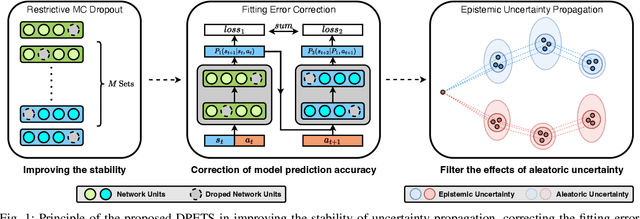
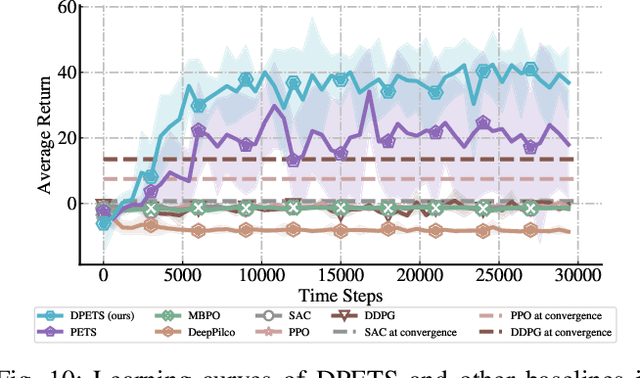
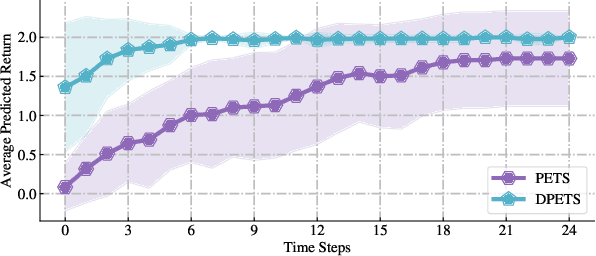
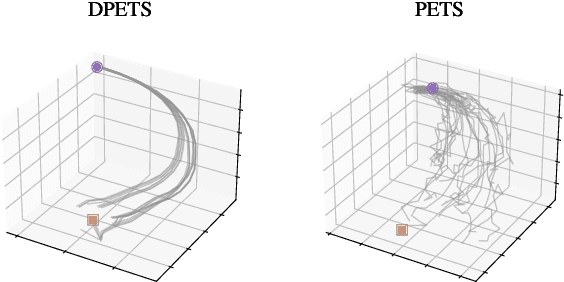
Abstract:This paper addresses the prediction stability, prediction accuracy and control capability of the current probabilistic model-based reinforcement learning (MBRL) built on neural networks. A novel approach dropout-based probabilistic ensembles with trajectory sampling (DPETS) is proposed where the system uncertainty is stably predicted by combining the Monte-Carlo dropout and trajectory sampling in one framework. Its loss function is designed to correct the fitting error of neural networks for more accurate prediction of probabilistic models. The state propagation in its policy is extended to filter the aleatoric uncertainty for superior control capability. Evaluated by several Mujoco benchmark control tasks under additional disturbances and one practical robot arm manipulation task, DPETS outperforms related MBRL approaches in both average return and convergence velocity while achieving superior performance than well-known model-free baselines with significant sample efficiency. The open source code of DPETS is available at https://github.com/mrjun123/DPETS.
A Self-supervised Contrastive Learning Method for Grasp Outcomes Prediction
Jun 26, 2023

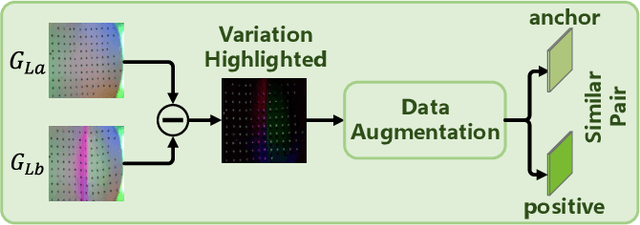
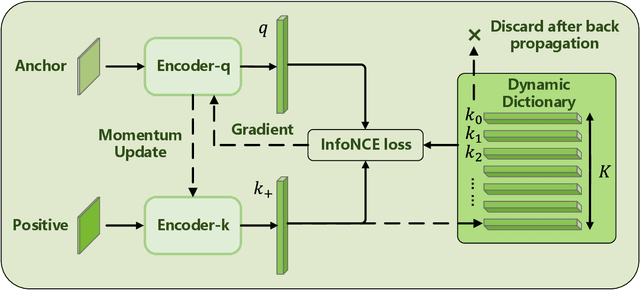
Abstract:In this paper, we investigate the effectiveness of contrastive learning methods for predicting grasp outcomes in an unsupervised manner. By utilizing a publicly available dataset, we demonstrate that contrastive learning methods perform well on the task of grasp outcomes prediction. Specifically, the dynamic-dictionary-based method with the momentum updating technique achieves a satisfactory accuracy of 81.83% using data from one single tactile sensor, outperforming other unsupervised methods. Our results reveal the potential of contrastive learning methods for applications in the field of robot grasping and highlight the importance of accurate grasp prediction for achieving stable grasps.
 Add to Chrome
Add to Chrome Add to Firefox
Add to Firefox Add to Edge
Add to Edge